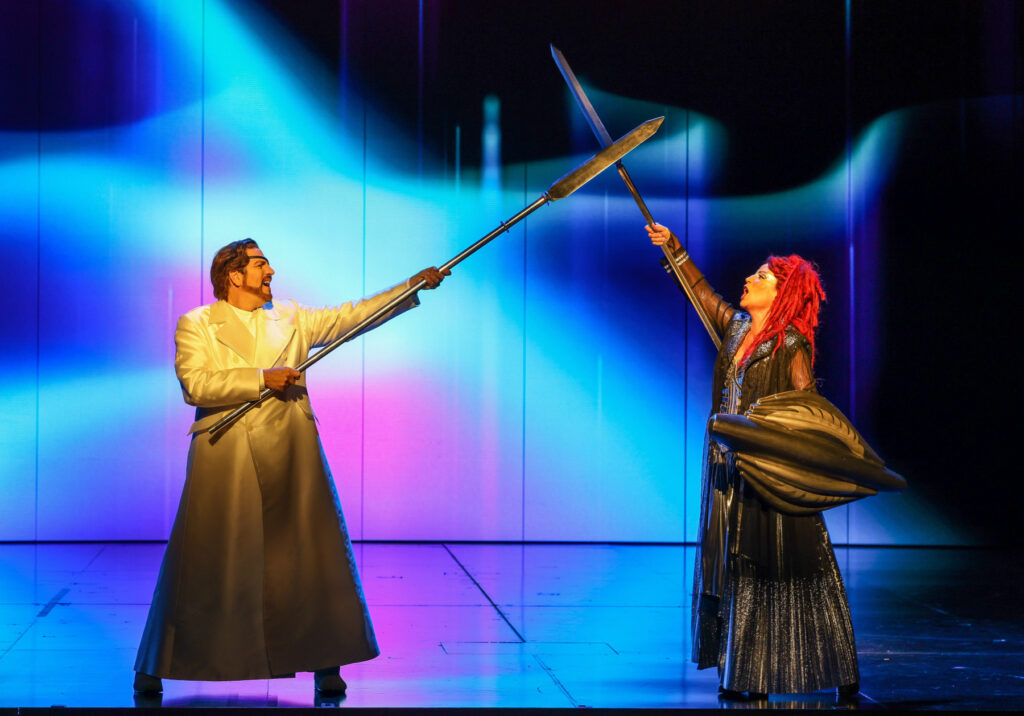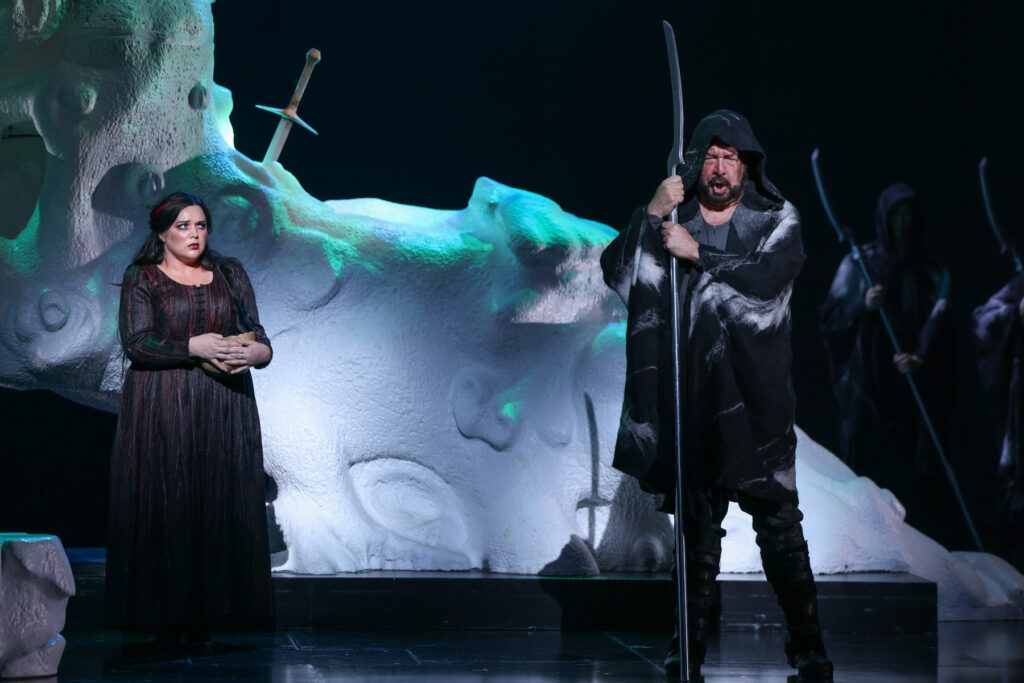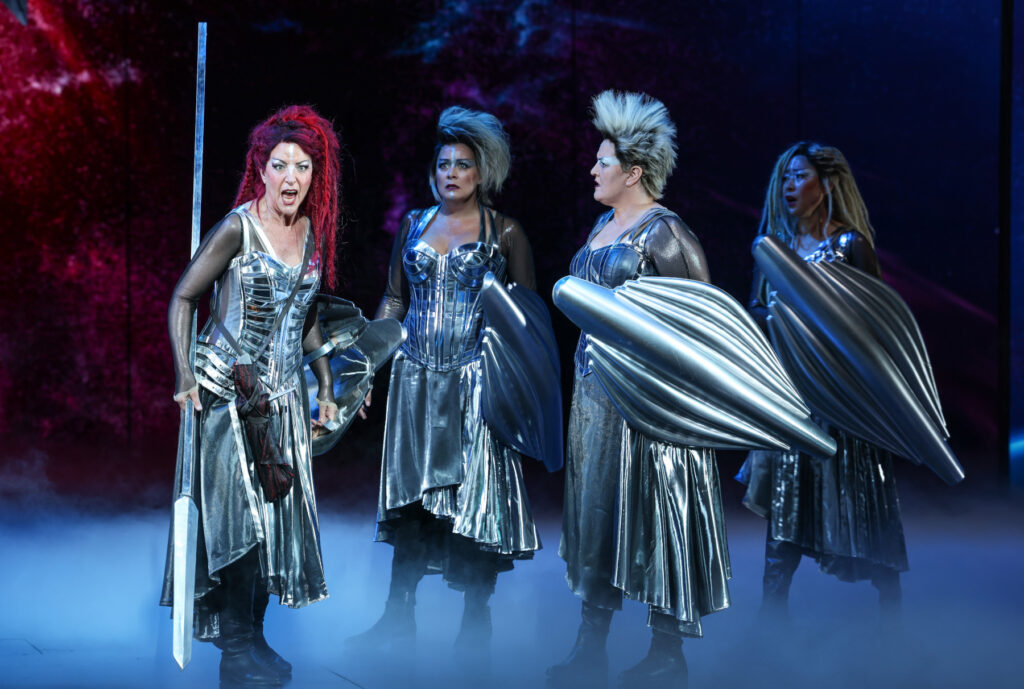For all Chinese-born, New York-based director Chen Shi-Zheng’s attempts to posit Wagner’s 4-part Der Ring des Nibelungen as “modern science fiction” in a multiverse setting, all the archetypal elements Wagner wrote into his more than 15-hour epic, inspired by German and Nordic myths and folk tales, are still there – that is, up to this point at the conclusion of Die Walküre. In that regard, it counts for something in retelling Wagner’s vast opus with a satisfying degree of legibility.
When the curtain came down on this second installment, those elements, the dramatic tension realized through Chen’s more focused direction of characters than seen in Das Rheingold and the excellence in orchestral and vocal execution combined for a convincing triumph.
But how effective or instrumental is the digital content created by chief designer Leigh Sachwitz and her team at Berlin-based flora&faunavisions in shaping and progressing Chen’s concept? It’s a question that seems to persist as each new scene is revealed. First of all, ideas of varied intercultural influences to create a sense of universality that peeped through in Das Rheingold, with a strong reliance on elements taken from traditional Chinese culture to create the association with those that Wagner wrote into his work, are also evident in Die Walküre.

If there is any substance in Chen’s idea of a multiverse setting, however, it’s a piecemeal veneer of imagery that often seduces, often baffles and sometimes breaks that indescribable connection an audience has with a streamlined theatrical immersion often taken for granted. Take it away, retain all the archetypal elements that emerge and much of the digital effects might at times feel superfluous.
In Die Walküre, the cursed ring is only spoken of but here we are introduced to the ash tree in the form of a giant bonsai-like carved Chinese figurine and forms a magnificent centerpiece in a darkened space – apart from streams of distracting rising and falling digital ‘rain’ to suggest, perhaps, unorthodox laws of physics. Later, it transforms through changing seasons under a flurry of confetti, both real and digital, as sibling twins Siegmund and Sieglinde bask in their unstoppable love in a thoughtfully romanticized and most memorable scene.
“Nothung” is, playing it safe, very much the Medieval knight’s sword to a tee. The hillock on which Brünnhilde’s punishment is enacted is a giant horizontal-cut rock supported on spears, iceberg-like when it first appears in its cavernous stalagmite digital setting. And the ring of fire surrounding it to ward off all but the bravest of heroes – in an otherworldly coexistence of ice and fire – rolls in as a dragon-headed snake before a digitally shot flame rockets in to light it. Chen also makes a mild deviation in imagining Brünnhilde’s steed Grane as a stylized three-part phoenix – a symbol associated with good fortune in Chinese culture – operated by puppeteers.

Wagner gives much to mull over, as does Chen, as Das Rheingold’s broader landscape of power, greed and the renouncement of love are referred back to in Die Walküre which hones in on characters caught in the unpredictability of love, nuanced psychological deliberations and speculations on power and divinity. Each of its characters have battles to overcome and are powerfully drawn in Chen’s direction.
The grim nature of Act 1’s domestic setting is conveyed with much sentience as Sieglinde’s awful life in a forced and abusive marriage to Hunding is turned around when Siegmund – the two being strangers to each other – arrives injured. Both are equally vulnerable, instantly attracted to each other and rendered convincingly by Anna-Louise Cole and Rosario La Spina respectively.
Cole gives lashings of vocal contrast and emotivity and builds a finely tuned performance to highlight Sieglinde’s remarkable courage channeled through love. Ticket holders to the third cycle will have the chance to see Cole debut as Brünnhilde and if the stamina is maintained, her performance should prove to be marvelous.

La Spina is a similarly persuasive presence, his warm Italianate tone giving way to meaty Germanic colors and firing up without any trouble to deliver projection-perfect fullness and clarity as he sported Siegmund’s valiant heart and humanity. Andrea Silvestrelli is a stop-start brutish Hunding who doesn’t quite step out of his role as Das Rheingold’s clomping Fafner but certainly chills the air, especially so when violently pulling back on Sieglinde’s hair.
The unshakable sanctity of marriage pitted against desirous love are the drivers of Act 2’s drama when the wife-straying Wotan (Daniel Sumegi) and goddess of marriage Fricka (Deborah Humble) come face to face. No doubt remains as to whose side each takes in the relationships dramatized in Act 1. Movements and gestures are economical and precise as Sumegi and Humble, both glowing in debut roles, create a thrilling essay on morality in one of several highlights of Act 2 that make it the most compelling act so far.
As Brünnhilde, in a shiny metallic silver tunic with dreadlocks like roots to associate her being Erda’s offspring, Lise Lindstrom effortlessly barrels into top form the moment her penetrating warrior-woman ho-jo-to-hos open the act. Sharing a brief endearing moment with Wotan, who instructs her to protect Siegmund in his battle with Hunding, she serves a splendid bite-sized hoes-d’œuvre before she so radiantly delivers the message in Siegmund! Sieh aid mich! and, moved by Siegmund’s love for Sieglinde, sculpts profound vocal sensitivity with it.
Throughout Act 2, the digital imagery is astutely restrained and, to give credit, supportively decorative. Concluding in a spatially abstracted structure through which Hunding and his evocatively choreographed men hunt down Siegmund, the energy and terror of the fight comes as a jolt to the emotions as Siegmund’s life is taken and sets up Act 3 for a much anticipated confrontation between Brünnhilde and Wotan.
The Ring’s most popularized music, Ride of the Valkyries, begins Act 3 and a huge vehicular metallic phoenix, on which ride Brünnhilde’s eight similarly uniformed and bold-voiced warrior sisters, descends to the floor around a small army of dancers. It’s a gargantuan theatrical contrivance and an audience hit but a spectacle reaching the point of garishness with its enveloping digital fluorescence.
Nevertheless, Chen returns to the emotional rawness of the saga with his sharded icy landscape where Wotan farewells his errant daughter Brünnhilde in a final scene that eloquently grafts a piece of mercifulness on punishment. Sumegi is at his Everest in conveying Wotan’s inner pain and conflicting emotions with his formidable signature guttural tones and firmly resonant vocals while making Wotan’s journey – having started seemingly eons ago – a riveting one. And, having given a wealth of heartfelt vocal prowess, there is so much more of Lindstrom to look forward to when Brünnhilde is awoken in Siegfried.
In the pit, the expertise shined with the sense that Queensland Symphony Orchestra is well-settled. With conductor Philippe Auguin perhaps taking increasingly incisive risks to extract the most out the Wagner’s lush swathes of music, the next two parts are in much appreciated hands.
Paul Selar
Top Image: Angela Hogan as Grimgerde, Jane Ede as Gerhilde, Dominica Matthews as Schwertleite, Jennifer Black as Ortlinde, Ruth Strutt as Rossweisse, Mariana Hong as Helmwige, and Agnes Sarkis as Siegrune
Photo Credit: Wallis Media